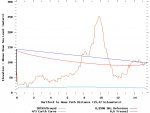TEKurtz
Member
I've searched around this site as well as others off and on for a while now trying to find any information with no avail. I had a thought a while back while trying to receive a somewhat local EDACS 800 system, and I wondered if this theory has been implemented or tested.
Wilson (among other brands) makes a cellular amplifier to be paired with a receiving and repeating antenna in the 800mhz and 1900mhz cell ranges, one made specifically for iDen 800mhz. My question is does anyone know if the normal cell amplifier/repeater or the iDEN version will work with an EDACS 800 system?
Just so there is no confusion, I'm not trying to extend the range of EDACS system to the neighborhood, I would like to pair my yagi antenna with the amp to repeat from an indoor antenna inside the house. Any thoughts?
Wilson (among other brands) makes a cellular amplifier to be paired with a receiving and repeating antenna in the 800mhz and 1900mhz cell ranges, one made specifically for iDen 800mhz. My question is does anyone know if the normal cell amplifier/repeater or the iDEN version will work with an EDACS 800 system?
Just so there is no confusion, I'm not trying to extend the range of EDACS system to the neighborhood, I would like to pair my yagi antenna with the amp to repeat from an indoor antenna inside the house. Any thoughts?


